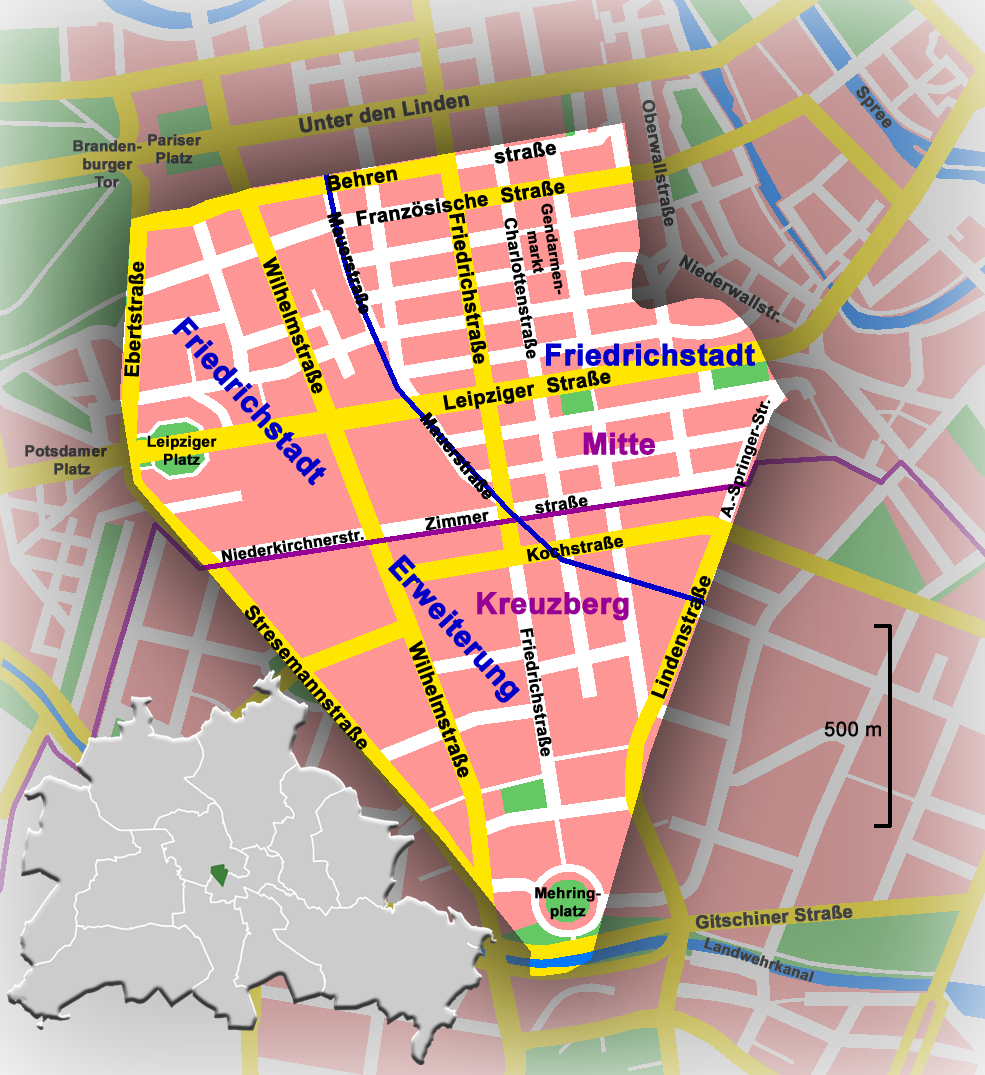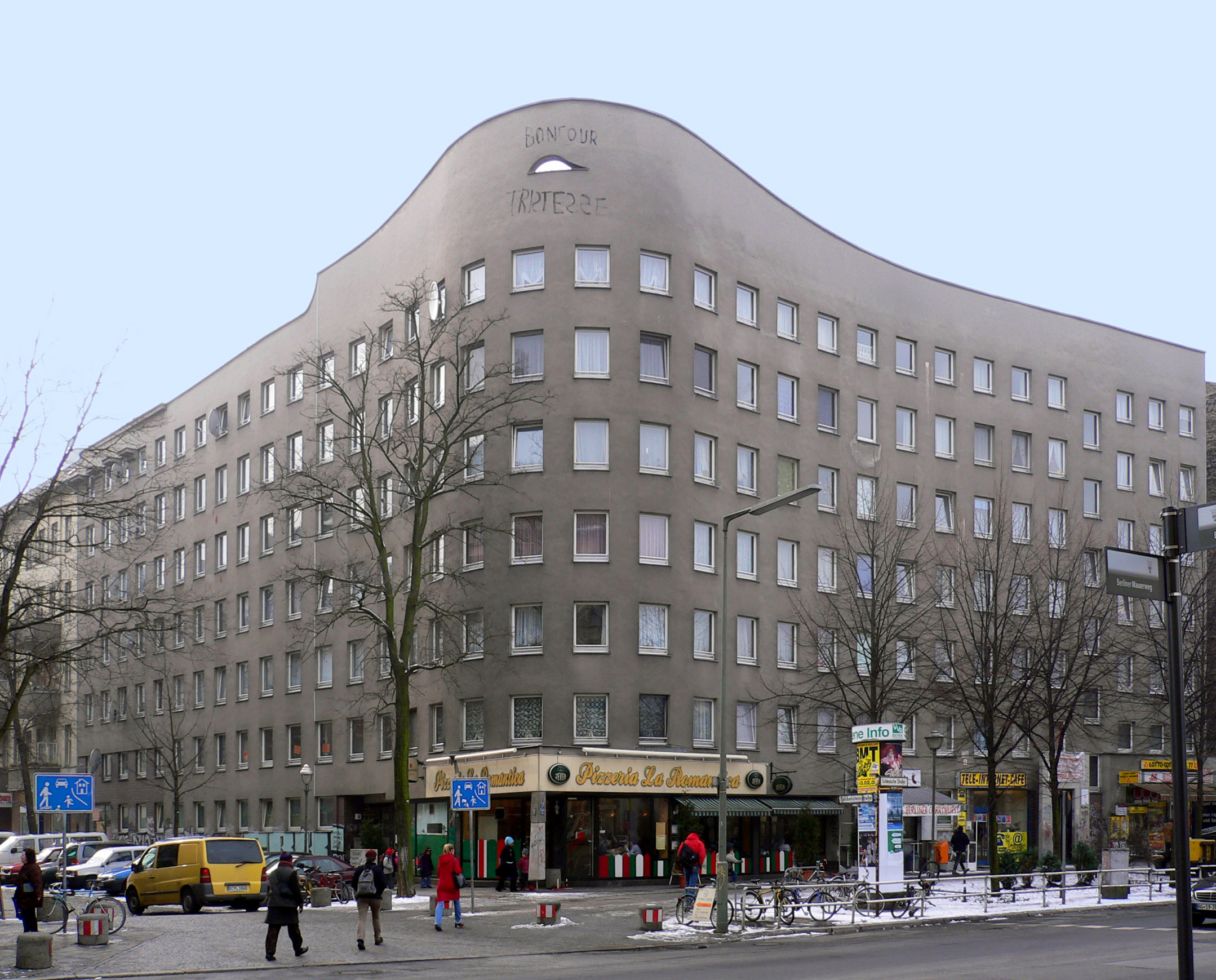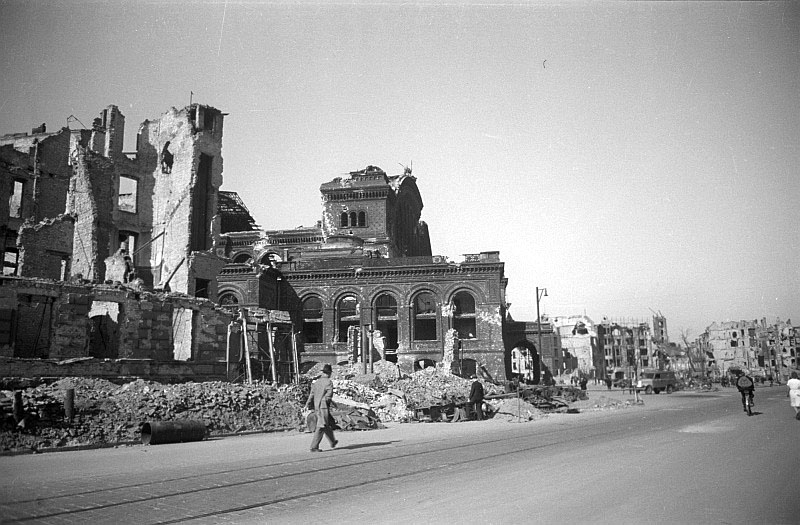|
Mehringplatz
Mehringplatz is a round plaza (or circus)A circus is "circular open space at a street junction" at the southern tip of the Friedrichstadt neighborhood of Kreuzberg district, Berlin. It marks the southern end of Friedrichstraße. Until 1970 both Lindenstraße and Wilhelmstrasse led into it. In 1947 it was renamed after the publicist Franz Mehring (1846–1919). Mehringplatz is one of three prominent squares laid out about 1730 in the course of the city's Baroque extension under King Frederick William I of Prussia, along with Pariser Platz (former ''Karree'') and Leipziger Platz (''Octagon''). Due to its circular shape, Mehringplatz was initially named ''Rondell''; but on 22 October 1815, it was renamed ''Belle-Alliance-Platz'' after the ''Battle of La Belle Alliance'', an alternative name for the Battle of Waterloo that was then popular in Prussia. ''Rondell'' was the southern entrance to Berlin via ''Hallesches Tor'', a gate on the newer city wall on the outbound road to ... [...More Info...] [...Related Items...] OR: [Wikipedia] [Google] [Baidu] |
Berlin Peace Column
The Peace Column (German: Friedenssäule) is a column located in Mehringplatz in Berlin, Germany. Designed by Christian Gottlieb Cantian and erected in 1843, the 19-meter column is topped with a brass statue of Victoria, goddess of victory, designed by Christian Daniel Rauch. In 1876, allegories of the four victorious allies of Waterloo Waterloo most commonly refers to: * Battle of Waterloo, 1815 battle where Napoleon's French army was defeated by Anglo-allied and Prussian forces * Waterloo, Belgium Waterloo may also refer to: Other places Australia * Waterloo, New South Wale ... (or Belle Alliance in Prussian historiography) were added, and in 1879 two more sculptures followed: ''The Peace'' by Albert Wolff and ''Clio'', writing the history of the Wars of Liberation (Befreiungskriege) by . See also * 1843 in art References External links * 1843 establishments in the German Confederation PeaceColumn Monumental columns in Germany Outdoor sculptures in Ber ... [...More Info...] [...Related Items...] OR: [Wikipedia] [Google] [Baidu] |
Mehringdamm
The Mehringdamm is a street in southern Kreuzberg, Berlin. In the north it starts at Mehringbrücke and ends - with its southernmost houses already belonging to Tempelhof locality - on Platz der Luftbrücke. It is the historical southbound Berlin-Halle highway, now forming the federal route 96. The main junction of Mehringdamm is with the 19th-century ring road around Berlin's inner city, named Yorckstraße west, and Gneisenaustraße east of Mehringdamm. History The highway from Cölln (since 1710 a part of Berlin) to Halle upon Saale and Leipzig traverses the quarter of Tempelhofer Vorstadt (Bezirksregion II of Friedrichshain-Kreuzberg) from north to south on a length of .''Baedekers Berlin-Kreuzberg: Bezirksführer'' (11977), Ostfildern/Kemnat and Munich: Baedeker, 21988, p. 37. . Before it was paved, horses and coaches going up the highway to the level of the Teltow Plateau, rising between Bergmannstraße and Fidicinstraße by ,Klaus-Dieter Wille, ''Spazie ... [...More Info...] [...Related Items...] OR: [Wikipedia] [Google] [Baidu] |
Friedrichstraße
Friedrichstraße, or Friedrichstrasse (see ß; ) (lit. ''Frederick Street''), is a major culture and shopping street in central Berlin, forming the core of the Friedrichstadt neighborhood and giving the name to Berlin Friedrichstraße station. It runs from the northern part of the old Mitte district (north of which it is called Chausseestraße) to the Hallesches Tor in the district of Kreuzberg. This downtown area is known for its expensive real estate market and the campus of the Hertie School of Governance. Due to its north-southerly direction, it forms important junctions with the east-western axes, most notably with Leipziger Straße and Unter den Linden. The U6 U-Bahn line runs underneath. During the Cold War it was bisected by the Berlin Wall and was the location of Checkpoint Charlie. Overview As central Berlin's traditional shopping street, Friedrichstraße is three blocks east of the parallel Wilhelmstraße, the historic heart of the old government quarte ... [...More Info...] [...Related Items...] OR: [Wikipedia] [Google] [Baidu] |
Akzisemauer
The Berlin Customs Wall (German: "Berliner Zoll- und Akzisemauer", literally ''Berlin customs and excise wall'' the German term had been originally "Akzisemauer" / excise wall but with the fading knowledge of the term "excise" most references incorporate "Zoll" / Customs to flag the function) was a ring wall around the historic city of Berlin, between 1737 and 1860; the wall itself had no defence function but was used to facilitate the levying of taxes on the import and export of goods (tariffs), which was the primary income of many cities at the time. History The wall was erected after the old Berlin Fortress was demolished in 1734; the walls of the latter had already started to crumble and its military function was questionable. Frederick William I of Prussia ordered the construction of stockades around the city which were completed in 1737 – the new ring fence incorporated the existing northern "palisade line" built in 1705. The location of this oldest stockade is recal ... [...More Info...] [...Related Items...] OR: [Wikipedia] [Google] [Baidu] |
Leipziger Platz
Leipziger Platz is an octagonal square in the center of Berlin. It is located along Leipziger Straße east of (and adjacent to) Potsdamer Platz. History Layout and original architecture The square with the shape of an octagon, initially also officially called ''Octogon'', was laid out together with the square-shaped Pariser Platz (also: Quareé) and the circular ''Belle-Alliance-Platz'' (also: Rondell, since 1947 Mehringplatz) according to plans by Philipp Gerlach in 1734 and increasingly enclosed by representative residential, administrative and commercial buildings. All three squares of the urban ensemble were named in 1814/1815 in memory of the wars of liberation. In 1814, the Octagon was given its name in memory of the Battle of the Nations near Leipzig (Völkerschlacht), aligned with Leipziger Straße, which had existed long before. In 1796, the Academy of Arts held a contest to design a memorial for Frederick II of Prussia. Friedrich Gilly proposed a temple monum ... [...More Info...] [...Related Items...] OR: [Wikipedia] [Google] [Baidu] |
Wilhelmstrasse
Wilhelmstraße, or Wilhelmstrasse (see ß; ; ) is a major thoroughfare in the central Mitte and Kreuzberg districts of Berlin, Germany. Until 1945, it was recognised as the centre of the government, first of the Kingdom of Prussia, and later of the unified German Reich, housing in particular the Reich Chancellery and the Foreign Office. The street's name was thus also frequently used as a metonym for overall German governmental administration: much as the term "Whitehall" is often used to signify the British governmental administration as a whole. In English, "the Wilhelmstrasse" usually referred to the German Foreign Office.See ''Daisy, Princess of Pless'' by Herself, p. 63. ''OED'', "Wilhelmstrasse" Course The Wilhelmstraße runs south from the Spree riverside through the historic Dorotheenstadt quarter to the Unter den Linden boulevard near Pariser Platz and Brandenburg Gate, where it takes on a line slightly east of south through adjacent Friedrichstadt, until i ... [...More Info...] [...Related Items...] OR: [Wikipedia] [Google] [Baidu] |
Franz Mehring
Franz Erdmann Mehring (27 February 1846 – 28 January 1919) was a German communist historian, literary and art critic, philosopher, and revolutionary socialist politician who was a senior member of the Spartacus League during the German Revolution of 1918–1919. He authored '' Karl Marx: The Story of His Life'' (1918), which was long considered the classical biography of Marx. Biography Early years Mehring was born 27 February 1846 in Schlawe, Pomerania, the son of a retired military officer and senior tax official. He studied classical philology at the University of Leipzig and received his doctorate in 1882 with the dissertation: "The German social democracy, their history and their teaching". Political career Mehring worked for various daily and weekly newspapers and over many years wrote lead articles for the weekly magazine . He was initially a supporter of liberal democratic ideals and allied himself with the national-liberal camp, however after being acquainted ... [...More Info...] [...Related Items...] OR: [Wikipedia] [Google] [Baidu] |
Friedrichstadt (Berlin)
Friedrichstadt was an independent suburb of Berlin, and is now a historical neighbourhood of the city itself. The neighbourhood is named after the Prussian king Frederick I. Geography Friedrichstadt is located south of the Dorotheenstadt neighbourhood, and southwest of the historical suburb of Friedrichswerder. It is located south of the twin-city zone of Berlin and Cölln. Today, the northern part of the neighbourhood is located in the borough of Berlin-Mitte, while the southern part of the neighbourhood is located in borough of Friedrichshain-Kreuzberg. The border between the two boroughs runs along the southern side of Niederkirchnerstraße and Zimmerstraße. The official boundaries of Friedrichstadt extend from the Spittelmarkt starting between northbound streets Niederwall- and Oberwallstraße, along Behrenstraße west to Ebertstraße, and then south over the Potsdamer Platz, Stresemann- and Gitschiner Straße, ending at the Hallesches Tor, and then again north over L ... [...More Info...] [...Related Items...] OR: [Wikipedia] [Google] [Baidu] |
Hallesches Tor (Berlin U-Bahn)
Hallesches Tor is a Berlin U-Bahn station in the central Kreuzberg quarter, served by lines U1 (Berlin), U1, U3 (Berlin), U3, and U6 (Berlin), U6. It is named after the historic ''Hallsches Tor'' (Halle (Saale), Halle Gate) of the Berlin Customs Wall, erected in the 18th century. Overview The historic gate of the Customs Wall, laid out from 1737 onwards to replace the medieval city fortifications, marked the southern tip of the Friedrichstadt (Berlin), Friedrichstadt neighbourhood. It was located at the southern end of Friedrichstraße and the ''Rondell'' (renamed ''La Belle Alliance, Belle-Alliance-Platz'' in 1815 and Mehringplatz in 1946). Neighbouring gates were on Potsdamer Platz in the west and on Wassertorplatz (Water Gate) in the east, where the present course of the U1 viaduct roughly corresponds to the former city wall. South of the gate, a wooden bridge led across the Landwehr Canal; from here the road ran via Tempelhof to the city of Halle, part of Brandenburg-Prussi ... [...More Info...] [...Related Items...] OR: [Wikipedia] [Google] [Baidu] |
Kreuzberg
Kreuzberg () is a district of Berlin, Germany. It is part of the Friedrichshain-Kreuzberg borough located south of Berlin-Mitte, Mitte. During the Cold War era, it was one of the poorest areas of West Berlin, but since German reunification in 1990, it has undergone significant gentrification and is now known for its vibrant arts scene. The borough is known for its large percentage of immigrants and descendants of immigrants, many of whom are of Turks in Germany, Turkish ancestry. This influx began in the 1960s and 1970s when West Germany invited 'Gastarbeiter' (guest workers) from various countries, including Turkey, Italy, Greece, and Yugoslavia, to address labour shortages and aid in Reconstruction of Germany, post-war reconstruction. As of 2006, 31.6% of Kreuzberg's inhabitants did not have German citizenship. Kreuzberg is known for its diverse cultural life and experimental alternative lifestyles, making it an attractive area for many. However, some parts of the district ar ... [...More Info...] [...Related Items...] OR: [Wikipedia] [Google] [Baidu] |
Buildings And Structures Completed In 1730
A building or edifice is an enclosed structure with a roof, walls and windows, usually standing permanently in one place, such as a house or factory. Buildings come in a variety of sizes, shapes, and functions, and have been adapted throughout history for numerous factors, from building materials available, to weather conditions, land prices, ground conditions, specific uses, prestige, and aesthetic reasons. To better understand the concept, see ''Nonbuilding structure'' for contrast. Buildings serve several societal needs – occupancy, primarily as shelter from weather, security, living space, privacy, to store belongings, and to comfortably live and work. A building as a shelter represents a physical separation of the human habitat (a place of comfort and safety) from the ''outside'' (a place that may be harsh and harmful at times). buildings have been objects or canvasses of much artistic expression. In recent years, interest in sustainable planning and building practi ... [...More Info...] [...Related Items...] OR: [Wikipedia] [Google] [Baidu] |
Victoria (mythology)
In ancient Roman religion Victoria was the deified personification of victory. She first appeared during the first Punic War, seemingly as a Romanised re-naming of Nike, the goddess of victory associated with Rome's Greek allies in the Greek mainland and in Magna Graecia. Thereafter she comes to symbolise Rome's eventual hegemony and right to rule. She is a deified abstraction, entitled to a cult. But unlike Nike, she has virtually no mythology of her own. History and iconography Victoria first appears during the first Punic War, as a translation or renaming of Nike, the Greek goddess of victory in peace or war. Nike would have become familiar to the Roman military as a goddess of Rome's Greek allies in the Punic Wars. She was worshipped in Magna Graecia and mainland Greece, and was a subject of Greek myth. Around this time, various Roman war-deities begin to receive the epithet ''victor'' (conqueror) or ''invictus'' (unconquered). By the late republican and early imper ... [...More Info...] [...Related Items...] OR: [Wikipedia] [Google] [Baidu] |







